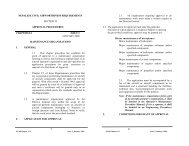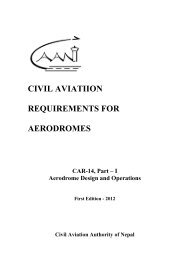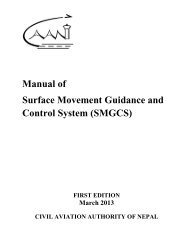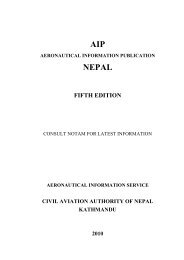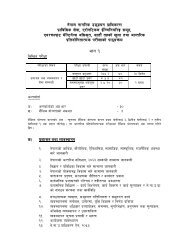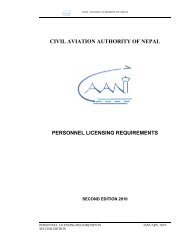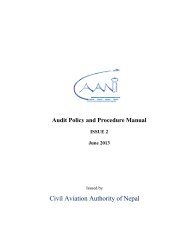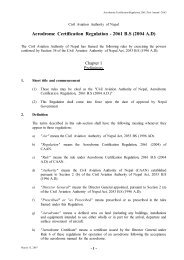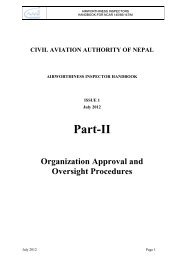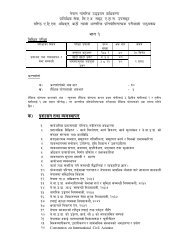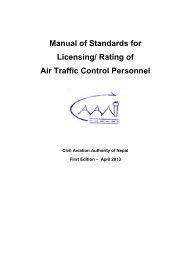CAAN Souvenir 2010.FH10 - Civil Aviation Authority of Nepal
CAAN Souvenir 2010.FH10 - Civil Aviation Authority of Nepal
CAAN Souvenir 2010.FH10 - Civil Aviation Authority of Nepal
- No tags were found...
You also want an ePaper? Increase the reach of your titles
YUMPU automatically turns print PDFs into web optimized ePapers that Google loves.
<strong>CAAN</strong> <strong>Souvenir</strong> 2010As given in the above model in the center there are AirportTerminal Buildings and Shopping Arcades, Air Cargo Facilities,Offices, Hotels and Parking Facilities. This core area is calledAirport City. In the outer side in one block, there is MedicalCluster, Technology Park and Sports Complex. In anotherblock, there is Industrial Park, and Free Trade Zone. DistributionCentres, Bonded Warehouses and area <strong>of</strong> special use is alsothere in the surroundings. Manufacturing, Flex Tech andResidential Area are also allocated. On the other side thereare Business Parks, Office Corridor, Hotels, World TradeComplexes and Convention Center. There are ICT Corridor,Merchandise Marts, Entertainment Districts and FactoryOutlets. This whole area combined is called Aerotropolis. Inthe facility side, there are roads, expressways and trainconnections to airport, airport city and aerotropolis fromaround multi-directions. In such a way Aerotropolis is acompact metropolis fully dedicated to produce and distributegoods and services in a well-planned setting.What the World is doing on Airport City andAerotropolis?The concept <strong>of</strong> Airport city began to emerge from the 1990’s.Many <strong>of</strong> the airports have already adopted this concept.Incheon airport <strong>of</strong> Korea has acquired a vast area <strong>of</strong> landto build ‘Air City’. They are integrating airport and seaport.In 2009 there has been 164 billion dollor <strong>of</strong> trade throughIncheon airport representing 24% <strong>of</strong> Korea’s total trade. Theyare planning to invest about 30 billion pound in Air Citydevelopment. Hong Kong airport has developed airport citynaming as ‘Sky City’. Aerotropolis concept is yet new. It iscoming from this very decade. Airports such as Memphis,Atalanta, Houston, and Detroit <strong>of</strong> the USA are adoptingaerotropolis concept. Dubai’s Al Maktoum InternationalAirport has a vast plan to develop aerotropolis. In india,Durgapore Airport will develop aerotropolis within a 9.0square kilometer area partnering with Singapore’s Changi.In Delhi airport GMR the airport operator has got land fromairports <strong>Authority</strong> <strong>of</strong> India for aerotropolis development.Why Airport City and Aerotropolis in SIA?As mentioned above, the concept <strong>of</strong> airport city andaerotropolis has been essential for airport’s long term financialsustainability. The site <strong>of</strong> Second International Airport (SIA)is going to be developed from the very green field status.Billions <strong>of</strong> dollar investment in SIA development has to befinancially sustainable. Investment should produce reasonablereturn on capital. Since projected traffic is not so high, wemust choose a business model to sustain in future. Forsustainability, we should follow suit as other successful worldairport operators are doing. It is probable that SIA will bedeveloped under BOOT modality. Private investors want tominimize the risk <strong>of</strong> loss. They want attractive return oninvestment. With availability <strong>of</strong> sufficient land, private airportdevelopers would favor to take airport city and Aerotropolisconcept in SIA.Nijgadh and its vicinity area are appropriate to aerotropolisdevelopment. Birgunj is a trading gateway <strong>of</strong> <strong>Nepal</strong>. Thereis modern dry port facility. Birjung-Pathlaiya is being developedas an industrial corridor. In Hetaunda (about 40 km) thereis already an industrial zone. Royal Chitwan national parka touristic destination <strong>of</strong> <strong>Nepal</strong> is reachable within two hourdrive. All these conditions are favourable for aerotropolisdevelopment in Nijgadh. Moreover, SIA can be an air cargohub to serve the transit trade between India-China via Tibet-<strong>Nepal</strong>. Furthermore, the feasibility for Airport City andAerotropolis development in SIA can be understood from thefollowing points:1. The SIA Site and Available Land:Nijgadh is in the mid development region <strong>of</strong> <strong>Nepal</strong>. It isadjacent to the East West Highway. Birgunj-Pathlaiya industrialcorridor is near by the site. There is a multi-model dry port inBirgunj. With a fast track connection, SIA would be withinone and half hour reach from Kathmandu (72 km) and 20minutes reach from Birgunj(25 km).Modern international airport especially in the context <strong>of</strong>developing airport city and aerotropolis, requires a vast landarea. There is plenty <strong>of</strong> government land available aroundthe SIA site. It is estimated that SIA would require about 8000hectares <strong>of</strong> land (80 square km). Most <strong>of</strong> the land <strong>of</strong> the sitearea is forest which is government owned. Private landacquisition will be minimum (within 100 hectares).2. Air Transport Feasibility:TIA has limitation <strong>of</strong> facility expansion for future air trafficand passenger growth. There is no feasibility <strong>of</strong> parallelrunway. Instrument landing system is not feasible. Due toproximity <strong>of</strong> hills in the north side, missed approach is noteasy for large aircrafts. Approach air space is already incongestion resulting in-sky queuing and holding. All thissituation is demanding the construction <strong>of</strong> a secondinternational airport in <strong>Nepal</strong>.At present, where there are two million international passengersin TIA, it may be said that SIA is not yet feasible in <strong>Nepal</strong>.But the concept <strong>of</strong> modern international airport developmentis to be taken differently. Even with a few million passengers,SIA can be feasible integrated with the concept <strong>of</strong> airportcity/aerotropolis.2.1 Traffic Forecast:Actual international passenger traffic <strong>of</strong> TIA in 2009 was2.03 million. Recently Asian Development Bank (ADB) hasgiven traffic projection <strong>of</strong> TIA in its Technical Assistance Report.This is a GDP based projection at 95% confidence level.Taking data <strong>of</strong> this projection, by 2028 SIA will get 3.17million. We assume that SIA will be completed by 2018 andTIA will also continue international operation even after SIAoperation goes on. On this basis the tentative passengershare between TIA and SIA would be seen as follows:3712 th Anniversary Publication



